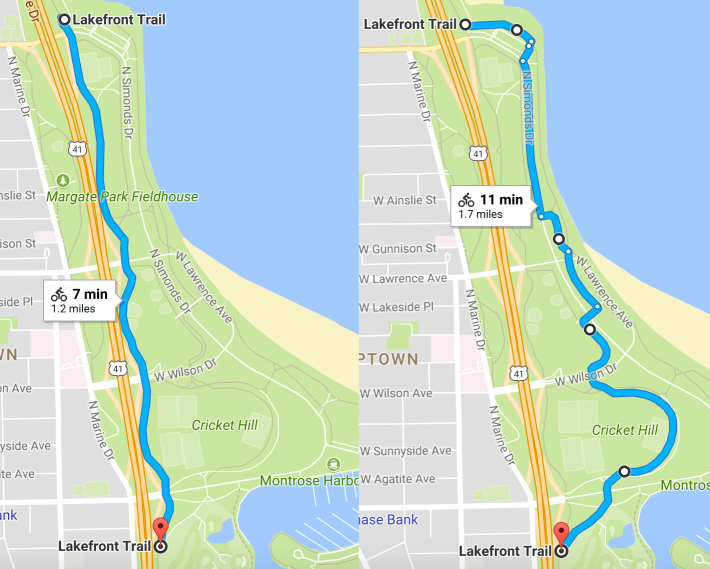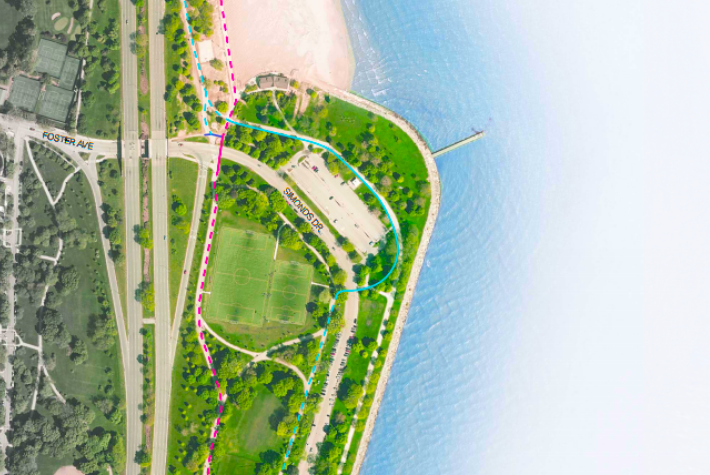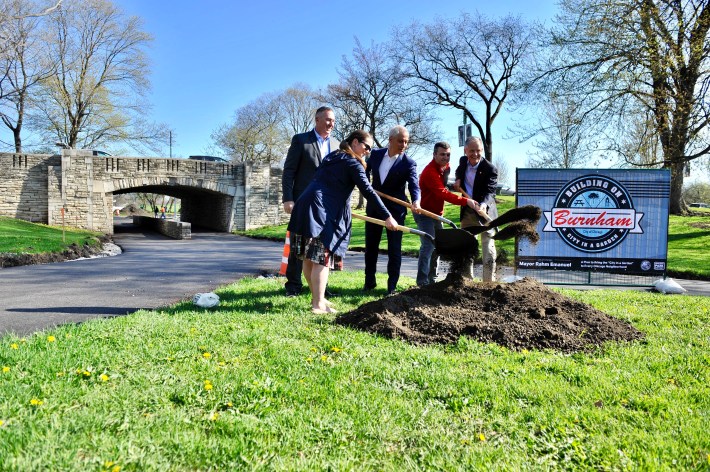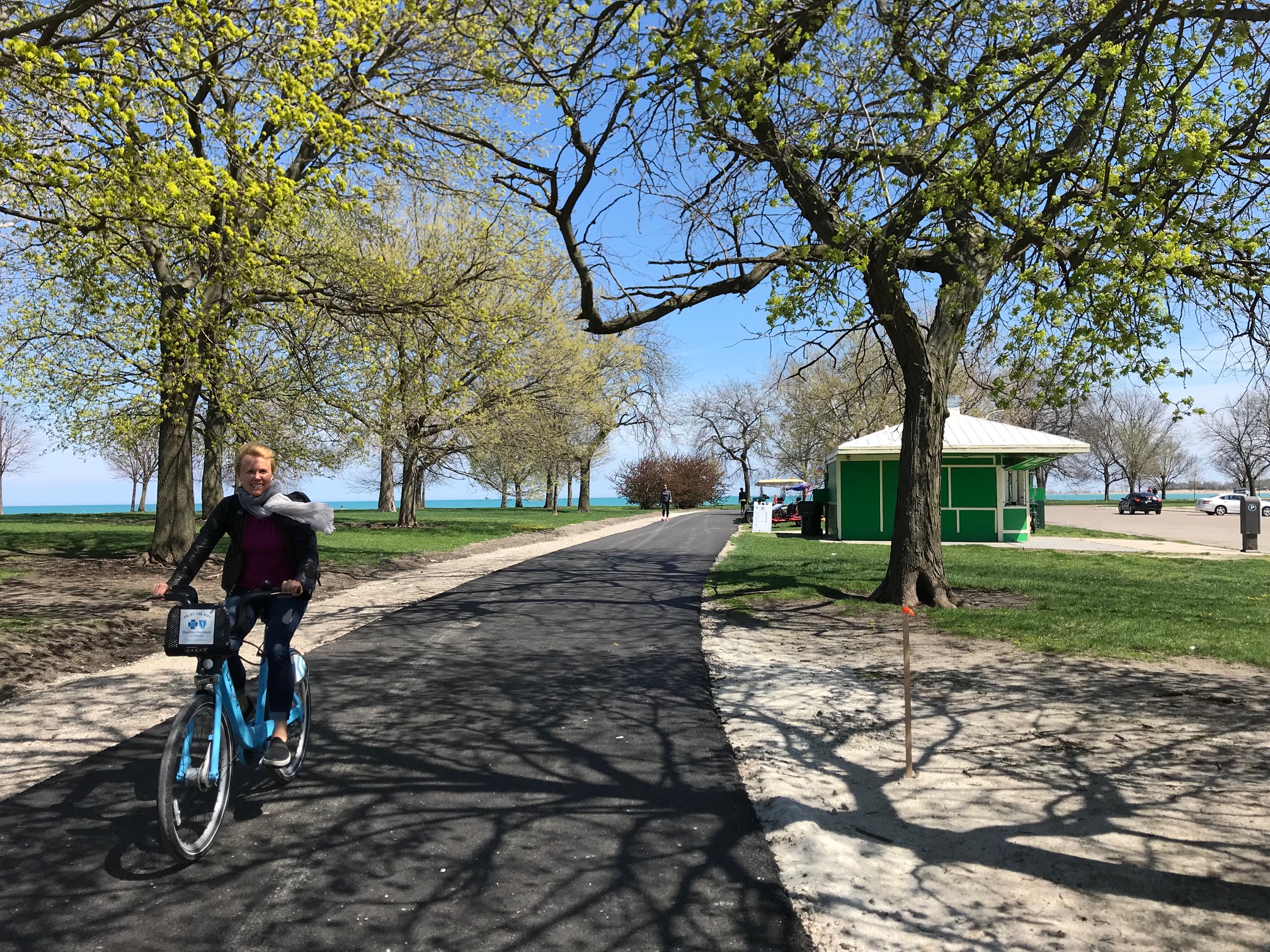Back in September I noted that the new bike route planned between Ardmore and Montrose as part of the Chicago Park District’s Lakefront Trail separation project would require cyclists to pedal an extra half mile, which could be annoying for commuters who are in a rush. But yesterday the Chicago Tribune’s Mary Wisniewski reported on an argument against the trail redesign I hadn’t heard before. Some Uptown residents are worried that the path reconfiguration, intended to reduce conflicts between bike riders and pedestrians, will create new hazards near Foster Beach.
On Monday city officials held a ground-breaking ceremony for the Ardmore-Montrose section, which should be completed later this spring. While the new pedestrian-only routes along the 18.5-mile trail will generally be located closer to Lake Michigan, while the bike-only paths will run closer to Lake Shore Drive, the section between Foster and Montrose is an exception.
On this stretch, new segments of paved bike path are being built east of the existing trail, which, combined with existing park paths, will route cyclists east past the Foster beach house and around a large parking lot. After that, the bike route crosses Simonds Drive, a coastal road, and runs along the west side of Simonds, using an existing underpass to cross Wilson Avenue. Next, the bike route detours east to circumnavigate Cricket Hill, the popular kite-flying and sledding spot, before meeting back up with pedestrian traffic to cross Montrose via another underpass. (The crash-prone existing path/street crossing at Montrose will be eliminated.)

While the new route may irritate some cyclists, a couple of Uptown residents told Wisniewski they’re concerned that the route could lead to other lakefront users being struck by them. One of the new bike path segments being built just south of Foster Beach runs along a wide, grassy lakeside expanse that’s perfect for picnicking. Margo McFarland said she’s worried about small children wandering across the trail and being hit by high-speed bike riders.
“I just don’t see how people who are serious commuters are going to take this diversion at a normal low speed,” McFarland told Wisniewski. “When you’re [picnicking] here or there, which they have every right to do… what’s to keep [kids] from running to the other side?”
Marianne Lalonde said she’s worried about folks with disabilities having to cross the bike path on their way from the large parking lot to the beach. She also complained that she hadn’t heard about the community meetings the park district held on the project.

While McFarland and Lalonde’s concerns are understandable, it’s important to remember that similar situations exist in other parts of the Lake Front Trail, particularly near 31st Street Beach, where cyclists are riding by families picnicking and barbecuing, and everyone needs to use a little extra caution. My sense is that bike riders and other park users will get used to the new configuration near Foster Beach and adjust their behavior accordingly. It’s also likely that many cyclists will ignore the new detour and stick to the more direct existing path, so there may not be a constant flow of bike traffic, even at busier times.
The park district plans to wrap up the rest of the Lakefront Trail separation project, largely funded by a $12 million grant from Republican hedge fund billionaire Ken Griffin, by the end of the year. A recent study by Chicago Area Runners Association and the Active Transportation Alliance found that the trail garners some 100,000 users a day on summer weekends. The trail separation sections from 31st Street to 41st Street, Oak Street to Ohio Street and Fullerton Avenue to North Avenue are complete.

One major fly in the ointment with the improvement of the shoreline path is the long-delayed Navy Pier Flyover. Last week WBEZ’s Monica Eng reported that the bike-ped bridge, which was originally supposed to open this spring, likely won’t open until 2020. The Chicago Department of Transportation has blamed the latest delay on complications with Lake Shore Drive’s Depression-era bridge over the Chicago River.
On the bright side, the Illinois Department of Transportation recently purchased guardrails to protect new bike-only Lakefront Trail paths on the South Side that run perilously close to LSD traffic. A series of recent car crashes in which vehicles wound up on the trail made it clear that the guardrails are sorely needed.





